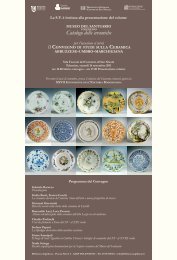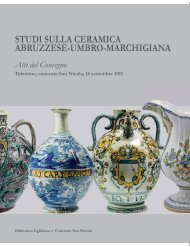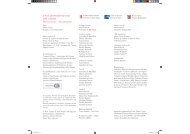Le maioliche rinascimentali nelle collezioni della ... - Claudio Paolinelli
Le maioliche rinascimentali nelle collezioni della ... - Claudio Paolinelli
Le maioliche rinascimentali nelle collezioni della ... - Claudio Paolinelli
Create successful ePaper yourself
Turn your PDF publications into a flip-book with our unique Google optimized e-Paper software.
137 Plate with Samson and trofei decoration.<br />
Pesaro or Urbino (workshop of Guido di Merlino), c1540.<br />
The plate is distinguished by an unusual decoration of trophies,<br />
on both the sides of the well and on the rim, in the first<br />
case over an elaborate decoration bianco sopra bianco (white on<br />
white) and in the second on a dark blue ground. The manly<br />
figure in the centre, rising to dominate the space, is probably<br />
to be identified as Samson. The muscular figure, beardless,<br />
with long flowing hair, wears a cloak and brandishes in his<br />
hand the jawbone of an ass. The painter has shown him standing,<br />
leaning his left hand on a thin spear. The colours are blue,<br />
green, brown, orange, yellow, and white. The outer edge is<br />
painted yellow.<br />
The jawbone of an ass with which, according to the Bible,<br />
Samson vanquished the Philistines, is, as often happens, simplified<br />
into the form of a sort of curved stick 1 . The Biblical figure<br />
is chosen as a symbol of virility but also as an emblem of<br />
masculine strength overcome by feminine charm and by passion.<br />
The entire decoration is on the theme of love. The<br />
evident unreciprocated love of the man presumed to have<br />
commissioned the plate 2 is explicitly referred to in two cartouches<br />
with the words aime tu me fai batista(?) bella morire [la]<br />
spera[n]za (alas you make my hopes die, beautiful Battista?) ;<br />
and camila diva mia be lla aime ti amo (my divine beautiful<br />
Camilla, alas I love you) 3 .<br />
The trophy decoration around the broad rim, alongside the<br />
normal military elements like shields and arms, has some unusual<br />
features, fruits of the imagination of a talented painter: a<br />
peacock with the face of a woman 4 ; a pomegranate and a<br />
pumpkin with a human mask issuing from it. These details can<br />
be interpreted as explicit references to the beloved woman or<br />
as symbolizing prosperity or fertility.<br />
428<br />
The trophies and emblems of love are painted in grisaille, with<br />
thin tones of pale brown, and decorated with little scrolls<br />
scratched through the blue ground to the white beneath 5 . This<br />
type of the ornament known as trofei is traditionally attributed<br />
to Castel Durante 6 , but recent studies 7 and finds have shown<br />
evidence too for production in Pesaro 9 . In the present state of<br />
knowledge, it is not possible to attribute maiolica with trofei to<br />
a single specific centre in the Duchy of Urbino, where it was<br />
“in use everywhere” 10 . On the basis of dated objects we may<br />
conclude that this particular version of the decoration did not<br />
extend beyond the middle of the sixteenth century 11 .<br />
The figure of Samson finds an iconographic parallel in a plate<br />
in the Museo Civico, Pesaro, attributed to the workshop of<br />
Girolamo di Lanfranco 12 . The style of the anatomy, however,<br />
is reminiscent of the hand of an as-yet unidentified painter<br />
who worked in the circle of Guido di Merlino and close to the<br />
style of the “painter of the Orpheus basin” 13 . However, other<br />
parallels may be made with maiolica more vaguely attributed<br />
to Urbino 14 . It may be that the grisaille trophies on the border<br />
will in future provide a principal element in a more definite<br />
attribution. [CP]<br />
Plate with shallow well and small foot ring. Tin-glazed front and back.<br />
Diam: 37.2 cm.<br />
Broken and mended with minor repainting. Chipping to the edge.<br />
There is blue spotting on the back.<br />
Provenance: Cesare Ugolini; Fabrizio Frizzi Baccioni.<br />
Bibliography: A. Bettini in Dal Poggetto 2004, no. XII.74.








